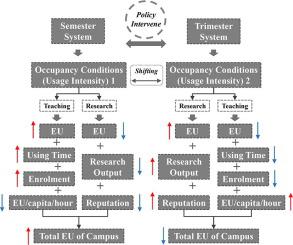当前位置:
X-MOL 学术
›
Energy Build.
›
论文详情
Our official English website, www.x-mol.net, welcomes your
feedback! (Note: you will need to create a separate account there.)
Reducing university energy use beyond energy retrofitting: The academic calendar impacts
Energy and Buildings ( IF 6.6 ) Pub Date : 2020-12-03 , DOI: 10.1016/j.enbuild.2020.110647 Xuechen Gui , Zhonghua Gou , Yi Lu
Energy and Buildings ( IF 6.6 ) Pub Date : 2020-12-03 , DOI: 10.1016/j.enbuild.2020.110647 Xuechen Gui , Zhonghua Gou , Yi Lu

|
With a strong commitment to sustainability, numerous universities set their carbon reduction targets, with the common measure being energy retrofitting of their campus buildings. Based on a complex understanding of the higher educational buildings’ energy consumption characteristics, this study addresses the role of the academic calendar that regulates the occupancy condition of campus buildings and consequently determines their energy consumption. Using an Australian university as a case study, the research collected energy data from its 122 campus buildings, analysed the data regarding the occupancy condition, and compared the data under two different academic calendars: semester and trimester. Among all campus building types, those used for teaching had the highest energy use, accounting for more than 50% of the whole campus energy consumption. Buildings that are used for research had the highest energy use intensity, at more than three times that of teaching. From a semester to a trimester academic calendar, the campus energy showed a reduction by 213,090 kWh per year (around 5% reduction). The energy consumption of teaching dedicated space decreased by 505,521 kWh per year (around 3% reduction), while that of research increased by 153,893 kWh per year (around 2% reduction). This indicated a decrease in teaching equivalent to an increase in research activities when transitioning to a more flexible enrolment calendar. The results suggest that the pattern of the occupancy condition regulated by the academic calendar should be adequately captured in the campus energy management and carbon reduction policy.
中文翻译:

除了能源改造之外减少大学能源使用:学术日历的影响
出于对可持续发展的坚定承诺,许多大学设定了碳减排目标,共同措施是对校园建筑进行能源改造。基于对高等教育建筑能源消耗特征的综合理解,本研究探讨了学术日历在调节校园建筑的占用条件并从而确定其能源消耗方面的作用。该研究以澳大利亚一所大学为案例,收集了其 122 座校园建筑的能源数据,分析了占用情况的数据,并比较了两种不同学术日历(学期和三个月)下的数据。在校园各类建筑中,教学建筑能耗最高,占整个校园能耗的50%以上。用于研究的建筑的能源使用强度最高,是教学建筑的三倍多。从一个学期到一个学期,校园能源每年减少 213,090 千瓦时(减少约 5%)。教学专用空间能耗每年减少505,521千瓦时(减少约3%),研究用电量每年增加153,893千瓦时(减少约2%)。这表明,在过渡到更灵活的招生日历时,教学的减少相当于研究活动的增加。研究结果表明,校园能源管理和碳减排政策应充分体现学术日历规定的占用条件模式。
更新日期:2020-12-03
中文翻译:

除了能源改造之外减少大学能源使用:学术日历的影响
出于对可持续发展的坚定承诺,许多大学设定了碳减排目标,共同措施是对校园建筑进行能源改造。基于对高等教育建筑能源消耗特征的综合理解,本研究探讨了学术日历在调节校园建筑的占用条件并从而确定其能源消耗方面的作用。该研究以澳大利亚一所大学为案例,收集了其 122 座校园建筑的能源数据,分析了占用情况的数据,并比较了两种不同学术日历(学期和三个月)下的数据。在校园各类建筑中,教学建筑能耗最高,占整个校园能耗的50%以上。用于研究的建筑的能源使用强度最高,是教学建筑的三倍多。从一个学期到一个学期,校园能源每年减少 213,090 千瓦时(减少约 5%)。教学专用空间能耗每年减少505,521千瓦时(减少约3%),研究用电量每年增加153,893千瓦时(减少约2%)。这表明,在过渡到更灵活的招生日历时,教学的减少相当于研究活动的增加。研究结果表明,校园能源管理和碳减排政策应充分体现学术日历规定的占用条件模式。











































 京公网安备 11010802027423号
京公网安备 11010802027423号